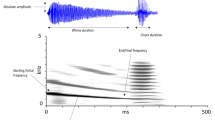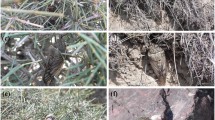Summary
-
1.
Experimental choruses of males of Cystosoma saundersii with manipulated densities ∼12 times that usually found in bushes of the same size were set up and compared with choruses with natural densities of males. Greater numbers of both males and females were attracted to the louder, denser choruses.
-
2.
There were higher rates of dispersal away from and movements within the experimental choruses than those found at natural densities. This indicated some form of repulsion occurring between males in close proximity.
-
3.
Playback experiments to calling males in the field showed that males would stop singing and move away in response to high intensities of a conspecific calling song. The intensities eliciting this reaction corresponded to a conspecific male singing at separations of less than or equal to 0.5 m. Aggression between males or aggressive songs have not been observed.
-
4.
Females fly in to the chorus and alight generally within 0.5 m of the male of their choice. They then produce a pheromone which they disperse by wingflicking. The rate of wing-flicking was used as a quantitative measure of the willingness of a female to mate.
-
5.
Twice as many females were attracted to higher densities of males than to natural densities. However, in the experimental situation, the probability of an attracted female actually mating was half that occurring in natural densities. This appeared to be due to an inhibition of the female wing-flicking behaviour.
-
6.
Playback experiments showed that females will respond by wing-flicking to a male only when his song is at least 9 dB louder than that of his nearest neighbour (when the sound pressure levels of the sources are measured separately at the position of the female). Using this figure as a threshold, volumes in which females would respond were calculated for males with a series of nearest-neighbour distances. At the average separation found between males sharing bushes in the field, the volume in which a female would respond covered most of the volume in which a female is likely to land. Thus, the discriminating capabilities of the female were shown to govern the minimum separation occurring between males.
Similar content being viewed by others
References
Alexander RD (1968) Arthropods. In: Sebeok JA (ed) Animal communication. Indiana University Press, Bloomington, pp 167–216
Alexander RD (1975) Natural selection and specialised chorusing behaviour in acoustical insects. In: Pimentel D (ed) Insects, science and society. Academic Press, New York, pp 35–77
Alexander RD, Moore TE (1958) Studies on the acoustical behaviour of 17 year cicadas. Ohio J Sci 58:107–127
Allan DA (1973) Some relationships of vocalisation to behaviour in the Pacific treefrog Hyla regilla. Herpetology 29:366–371
Blair WF (1968) Amphibians and reptiles. In: Sebeok TA (ed) Animal communication. Indiana University Press, Bloomington, pp 289–310
Campbell DJ, Shipp E (1979) Regulation of spatial pattern in a population of the field cricket, Teleogryllus commodus (Walker). Z Tierpsychol 51:260–268
Doolan JM, Mac Nally RC (1981) Spatial dynamics and breeding ecology of the cicada, Cystosoma saundersii: the interaction between resource distributions and intraspecific behaviour. J Anim Ecol 50 (in press)
Emlen ST (1968) Territoriality in the bull-frog, Rana catesbiana. Copeia 1968:240–243
Emlen ST (1976) Lek organisation and mating strategies in the bull-frog. Behav Ecol Sociobiol 1:283–313
Fletcher N, Hill KG (1978) Acoustics of sound production and of hearing in the bladder cicada, Cystosoma saundersii. J Exp Biol 72:43–55
Gayford ML (1976) Hi-Fi for the enthusiast. Pitman Publishing, London
Josephson RK, Young D (1979) Body temperature and singing in the bladder cicada, Cystosoma saundersii. J Exp Biol 80:69–81
Littlejohn MJ (1977) Long-range acoustic communication in anurans: an integrated and evolutionary approach. In: Taylor DH, Guttman SI (eds) The reproductive biology of Amphibians. Plenum, New York, pp 263–294
Lloyd JE (1971) Bioluminescent communication in insects. Ann Rev Entomol 16:97–122
Lloyd M, Dybas HS (1966) The periodical cicada problem. I. Population biology. Evolution 20:133–149
Mac Nally RC (1979) Social organisation and interspecific interactions in two sympatric species of Ranidella (Anura). Oecologia (Berl) 42:293–306
Mac Nally R, Young D (1981) Song energetics of the bladder cicada, Cystosoma saundersii. J Exp Biol 90:185–196
Michelsen A, Nocke H (1974) Biophysical aspects of sound communication in insects. Adv Insect Physiol 10:247–296
Morris GK (1971) Aggression in male conocephaline grasshoppers (Tettigoniidae). Anim Behav 19:291–322
Otte D, Joern A (1975) Insect territoriality and its evolution: population studies of desert grasshoppers on creosote bushes. J Anim Ecol 44:29–54
Pringle JWS (1954) A physiological analysis of cicada song. J Exp Biol 31:525–560
Simmons P, Young D (1978) The tymbal mechanism and song patterns of the bladder cicada Cystosoma saundersii. J Exp Biol 76:27–45
Sokal RR, Rohlf FJ (1969) Biometry. Freeman, San Francisco
Ulagaraj SM, Walker TJ (1973) Phonotaxis of crickets in flight: attraction of male and female crickets to male calling songs. Science 182:1278–1279
Wells KD (1977) The social behaviour of anuran amphibians. Anim Behav 25:666–693
Whitney CL (1973) The role of vocalisations in spacing out and mate selection in Pacific tree frogs. MSc thesis, University of British Columbia
Whitney CL, Krebs JR (1975) Spacing and calling in Pacific tree frogs, Hyla regilla. Can J Zool 53:1519–1527
Young D (1972a) Analysis of songs of some Australian cicadas (Homoptera: Cicadidae). J Aust Entomol Soc 11:237
Young D (1972b) Neuromuscular mechanism of sound production in Australian cicadas. J Comp Physiol 79:343–362
Young D (1980) The calling song of the bladder cicada Cystosoma saundersii: a computer analysis. J Exp Biol 88:407–411
Young D, Hill KG (1977) Structure and function of the auditory system of the cicada, Cystosoma saundersii. J Comp Physiol 117:23–45
Author information
Authors and Affiliations
Rights and permissions
About this article
Cite this article
Doolan, J.M. Male spacing and the influence of female courtship behaviour in the bladder cicada, Cystosoma saundersii westwood. Behav Ecol Sociobiol 9, 269–276 (1981). https://doi.org/10.1007/BF00299882
Received:
Accepted:
Issue Date:
DOI: https://doi.org/10.1007/BF00299882




